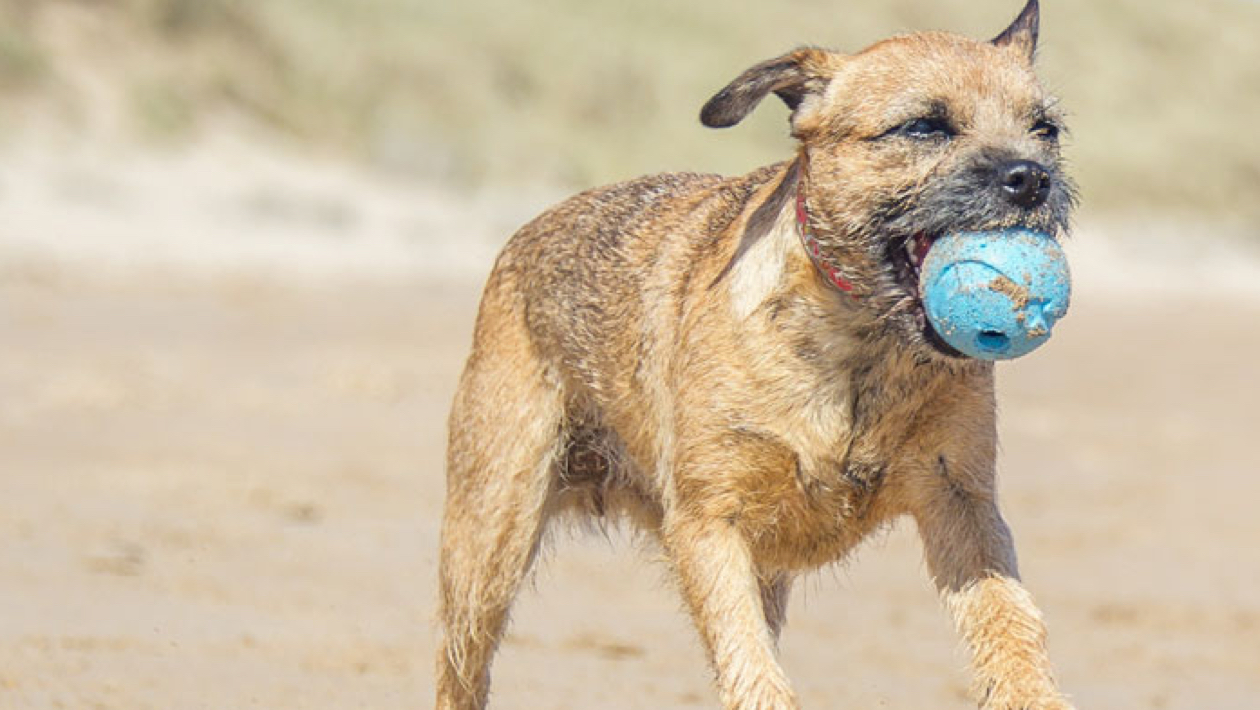
Border Terrier breed guide
Affectionate and lively, loving nothing more than the great outdoors. Border Terriers are smart, good-natured and active, making them a great addition to any family that loves walking. Learn more about this endearing and inquisitive breed, from their grooming and exercise needs to the things you can do to keep them happy and healthy.
Breed information and advice
As part of the terrier breed group, the Border Terrier is loyal, loving and determined. Make sure your garden or yard is fenced as if this dog gets bored they might try to escape. Here's more you should know:
- The Border Terrier was bred for assisting on hunts, so will naturally love to search and dig.The Border Terrier was bred for assisting on hunts, so will naturally love to search and dig.
- They’ll need brushing once a week and to have their hair properly groomed every five to six months to keep them looking smart.They’ll need brushing once a week and to have their hair properly groomed every five to six months to keep them looking smart.
- This dog is likely to weigh between 5kg and 7kg.This dog is likely to weigh between 5kg and 7kg.
- A healthy Border Terrier can live between 12 and 15 years.A healthy Border Terrier can live between 12 and 15 years.
Typical size of a Border Terrier: Small: 25cm-28cm

Recommended exercise and nutrition
You should aim to give your Border Terrier up to an hour of exercise each day. As they're active dogs they’ll enjoy being off the lead in a fenced garden at home, or an enclosed park where they can play games such as fetch. When walking it’s important to use a lead, as they can be quick to run off if they catch a scent. They’re fast learners but can be stubborn, so you may want to start training them while they’re puppies.
High-quality meals should be provided twice a day to make sure they're getting the right nutrients. The amount will vary depending on their age and how active they are. Always read the food packet for advice.
Up to one hour of exercise per day
Positive reinforcement should be used when training your dog, as Border Terriers were originally bred to be foxhunters and have strong independent streaks.

Common health problems and illnesses
Your Border Terrier will need all of the usual vaccinations and check-ups to help protect them against common ailments. There are some conditions which this breed is more prone to though, and you may want to familiarise yourself with the symptoms, so you know what to look out for.
A common injury affecting this breed is a dislocated kneecap, also known as a luxating patella. This is a condition that they’ll have been born with, and signs to look out for include occasional skipping or hind-leg lameness. Simple surgery is usually the best way to treat this condition, but your vet can advise on the best course of action.
Dogs with canine epileptoid cramping syndrome have episodes of painful muscle and intestinal cramps. Episodes last from a few seconds to up to about 30 minutes, and may be rare or occur frequently. Such cramping typically first starts to occur in dogs aged between 2 and 6 years and will then persist throughout the affected animal’s life. It appears to be a genetic disease but rather little is known about it. If you are concerned, please speak to your vet.
This breed can be prone to diabetes, when the pancreas does not produce any or enough of the hormone insulin. The disease is highly treatable in dogs, if you take action early. If your dog shows signs of extreme thirst, fatigue, excessive urination or unexplained weight loss, you might want to speak to your vet.
Border Terriers can have issues with their skin, from allergies leading to irritation, to skin disease or insect bites. Groom your dog regularly and you can then keep an eye out for any changes, such as scaling, that may develop. If you’re concerned about anything you find, speak to your vet who will be able to advise if treatment is needed.
Find out about insurance for your Border Terrier
Learn how pet insurance works and what kind of cover you might need for your dog.
Grooming advice
In order to keep your Border Terrier looking their best, you’ll need to brush them weekly and strip their fur every five to six months. Stripping requires plucking as much of the dead hair out by hand as possible, before using a special tool to get the rest. It’s something you can do yourself, but you may prefer to find a professional who can do this for you.
As your dog’s coat naturally repels dirt, they'll rarely need a bath. An occasional wipe down with a damp cloth after they've been brushed should be enough to keep them looking their best. Trim their nails when needed, usually once or twice a month, in order to keep their feet in good condition.
It’s a good idea to brush their teeth daily to keep tartar and any other harmful bacteria at bay.
Fun and interesting facts
- Tennis star Andy Murray and wife Kim are fans of this breed.
- Border Terriers are fast and agile due to their history as foxhunters, and have a strong instinct to hunt.
- They have two coats: the top layer is wiry and waterproof, while the under-layer is soft to insulate them.
- They were recognised as a breed by England’s prestigious Kennel Club in 1920.
- The breed dates back to the 18th century and originated on the Scottish and English border.
Important information
The content on this page aims to offer an informative introduction to pet breeds, but does not constitute expert veterinary advice. If your dog or cat falls ill or has an injury, contact your vet immediately.
All facts and figures were correct at date of publication and were compiled using a range of sources.
Discover more breeds
Browse our other cat and dog guides to learn about some of the UK’s most popular breeds.